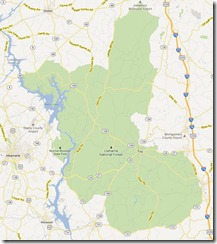My best friend and I rode the Harley-Davidson Crossbones tandem (with a backrest and much better passenger seat than shown) this past weekend down and back from Durham, where we live, to Charlotte to visit mutual friends.
We carved a route down through the central Piedmont region of North Carolina, taking a southern route through Uwharrie National Forest on the way down and returning along the more northerly Uwharrie Scenic Byway, a little more than 300 miles round-trip.
Uwharrie is also the name of a mountain range and we were stunned at the highest crest on that route returning north and east to see a spectacular “Blue Ridge” type view of a mountain range in the direction of Durham. 
I think it was probably the ridges of the small Cane Creek Mountain range that runs south and west from Burlington and Graham. I kick myself for not pulling over to take a photograph but by the time it registered we were in descent.
A little known secret in state tourism promotions which are heavily weighted toward the mountains and beaches is that not only is the central Piedmont the most visited portion of North Carolina, thanks to the draw of cities such as Durham and Charlotte, but it is also incredibly scenic if you stick to state roads and especially scenic byways rather than Interstates.
The Uwharrie is one of four national forests in North Carolina and at 51,000 acres it is the smallest. It is an actively managed forest but it also features a primitive area in the northern portion and recreation areas.
It is also being used to reforest 100 acres of longleaf pines each year. According to the new book American Canopy, a huge arc of longleaf forests once covered 140,000 square miles stretching through nine states from southwestern Virginia to Texas, enough to cover every inch of North Carolina three times.
Beginning in the 1880s, this vast forest was “exhausted over the course of ten to twenty years” by northern capitalists.
The devastation of that period led to the establishment of forestry schools such as the first one here in North Carolina at Biltmore near Asheville. Graduates were eventually hired by timber companies and helped usher in an era of sustainability.
The Uwharrie was purchased by the federal government during the Great Depression and made a national forest by President John F. Kennedy in 1961. Today, longleaf reforestation already covers 800 acres in the Uwharrie.
But North Carolina’s 1.3 million acres of national forest are about much more than sustainable forestry. Of the 7.5 million visitors to the forests each year, 48.5% go there to view scenery and 28% drive through them for pleasure, as we did last weekend, thereby adding to the renewable return on investment from these incredible natural resources.
North Carolina’s current legislature seems bent on sacrificing the state’s natural resources, first turning the scenic roadsides over to outdoor billboard companies for clear cutting at no charge and soon for natural gas fracking.
Hopefully before it is too late North Carolina voters will intervene.
No comments:
Post a Comment